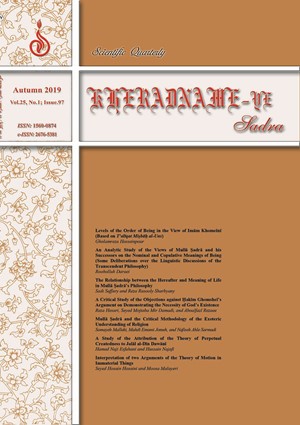-
-
List of Articles
-
Open Access Article
1 - Interpretation of two Arguments of the Theory of Motion in Immaterial Things
Seyed Hosain Hosaini Musa Malayeri -
Open Access Article
2 - Levels of the Order of Being in the View of Imām Khomeīnī (Based on T‘alīqāt Miṣbāḥ al-Uns)
Gholamreza Hosseinpour -
Open Access Article
3 - Mullā Ṣadrā and the Critical Methodology of the Exoteric Understanding of Religion
Somayeh Malleki Mahdi Emami Jomee Nafiseh Ahl Sarmadi -
Open Access Article
4 - A Critical Study of the Objections against Ḥakīm Ghomsheī’s Argument on Demonstrating the Necessity of God’s Existence
Reza Hesari Mojtaba Mirdamadi Abolfazl Rezai -
Open Access Article
5 - A Study of the Attribution of the Theory of Perpetual Createdness to Jalāl al-Dīn Dawānī
Hossein Najafi Hamed Naji Esfahani -
Open Access Article
6 - The Relationship between the Hereafter and Meaning of Life in Mullā Ṣadrā’s Philosophy
ٍSadi Saffary Reza Rasooly Sharbyany -
Open Access Article
7 - Editor note
Seyyed Mohammad Khamenei -
Open Access Article
8 - An Analytic Study of the Views of Mullā Ṣadrā and his Successors on the Nominal and Copulative Meanings of Being (Some Deliberations over the Linguistic Discussions of the Transcendent Philosophy)
Roohollah Daraei
-
The rights to this website are owned by the Raimag Press Management System.
Copyright © 2017-2026







